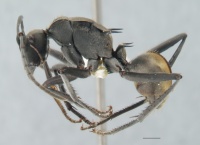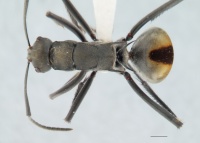Polyrhachis conciliata
| Polyrhachis conciliata | |
|---|---|
| Scientific classification | |
| Kingdom: | Animalia |
| Phylum: | Arthropoda |
| Class: | Insecta |
| Order: | Hymenoptera |
| Family: | Formicidae |
| Subfamily: | Formicinae |
| Tribe: | Camponotini |
| Genus: | Polyrhachis |
| Subgenus: | Hagiomyrma |
| Species group: | ammon |
| Species: | P. conciliata |
| Binomial name | |
| Polyrhachis conciliata Kohout, 2013 | |
Workers of Polyrhachis conciliata and Polyrhachis callima have been collected in close proximity and, at the type locality, their nests were located only a few metres apart. They nest in soil with the entrances covered by a stone or piece of wood.
Identification
A member of the ammon species-group in the Polyrhachis subgenus Hagiomyrma. Polyrhachis conciliata is very similar to Polyrhachis callima, with distinguishing characters given under the latter species.
Keys including this Species
Distribution
Latitudinal Distribution Pattern
Latitudinal Range: -23.75° to -23.8°.
| North Temperate |
North Subtropical |
Tropical | South Subtropical |
South Temperate |
- Source: AntMaps
Distribution based on Regional Taxon Lists
Australasian Region: Australia (type locality).
Distribution based on AntMaps
Distribution based on AntWeb specimens
Check data from AntWeb
Countries Occupied
| Number of countries occupied by this species based on AntWiki Regional Taxon Lists. In general, fewer countries occupied indicates a narrower range, while more countries indicates a more widespread species. |

|
Estimated Abundance
| Relative abundance based on number of AntMaps records per species (this species within the purple bar). Fewer records (to the left) indicates a less abundant/encountered species while more records (to the right) indicates more abundant/encountered species. |

|
Biology
Castes
Males unknown. Immature stages (eggs, larvae and pupae) in QM spirit collection.
Nomenclature
The following information is derived from Barry Bolton's Online Catalogue of the Ants of the World.
- conciliata. Polyrhachis (Hagiomyrma) conciliata Kohout, 2013: 514, figs. 3A-B (w.q.) AUSTRALIA.
Unless otherwise noted the text for the remainder of this section is reported from the publication that includes the original description.
Description
Worker
(holotype cited first): TL c. 11.09, 10.28-11.24; HL 2.56, 2.37-2.56; HW 2.03, 1.81-2.06; CI 79, 76-82; SL3.33, 3.07-3.33; SI 164, 157-178; PW 1.68, 1.48- 1.68; MW 1.27, 1.15-1.28; PMI 132, 122-139; MTL 4.33, 3.93-4.33 (26 measured).
Anterior clypeal margin with median, denticulate flange, laterally flanked by acute, laterally directed teeth. Clypeus with median carina; in profile shallowly concave anteriorly, straight posteriorly towards virtually flat basal margin. Frontal triangle shallowly impressed. Frontal carinae with raised margins; central area relatively wide and flat with frontal furrow replaced with weakly raised ridge. Sides of head in front of eyes converging towards mandibular bases in virtually straight line; behind eyes, sides converging into weakly convex occipital margin. Eyes situated close to occipital corners, convex, in full face view clearly exceeding lateral cephalic outline. Ocelli lacking. Pronotal dorsum with humeri moderately dilated, rounded with upturned margins; lateral margins behind humeri weakly notched in some specimens, parallel towards promesonotal suture. Mesonotal dorsum with posteriorly converging margins. Propodeum with lateral margins divergent, terminating in subparallel, acute spines, tips weakly turned outwards; propodeal dorsum widely rounding into distinctly convex propodeal declivity. Petiole with dorsum narrowly rounded, weakly convex medially, armed with divergent, acute spines. Anterior face of first gastral segment widely rounding onto dorsum.
Mandibles finely longitudinally striate with numerous piliferous pits. Head and mesosoma very finely and closely reticulate-punctate with sculpturation on sides of head somewhat more distinct. Gaster finely shagreened.
Mandibles with numerous medium length, golden hairs, distinctly longer at masticatory borders, shorter towards mandibular bases. Numerous, anteriorly directed setae fringing anterior clypeal margin. Several medium length hairs on clypeus, along frontal carinae and vertex, but no hairs breaking lateral outline of head in full face view. Several, medium length, semierect golden hairs on pronotal dorsum; long hairs, almost reaching greatest diameter of eyes in length, on anterior aspect of front coxae; somewhat shorter hairs on middle and hind coxae, below propodeal spiracles and on petiolar dorsum. Mesonotal and propodeal dorsa completely without hairs. Gaster with numerous, golden, posteriorly inclined hairs, longest on gastral venter and around apex, almost reaching greatest diameter of eyes in length. Very sparse, closely appressed, mostly silvery pubescence on dorsum of mesosoma; pubescence more abundant on head, sides of mesosoma and petiole. Abundant, closely appressed, somewhat medially radiating pubescence over all gastral surfaces, obscuring underlying sculturation; pubescence silvery on venter, rich golden with distinct, dark reddish-brown, median patch on gastral dorsum.
Black with only mandibles very dark reddish brown; condylae medium reddish-brown.
Queen
TL c. 12.20-12.65; HL 2.18- 2.25; HW 1.75-1.68; CI 74-79; SL 2.87-2.91; SI 164- 174; PW 2.70-2.74; MTL 3.83-3.88 (3 measured).
Apart from sexual characters, similar to worker except: pronotal dorsum with humeri narrowly rounded, margins shallowly emarginate posteriorly. Mesoscutum virtually as long as wide; anterior margin evenly rounded; median line distinct, bifurcate anteriorly; parapsides rather flat; mesoscutum flat in lateral view, mesoscutellum convex, distinctly elevated above dorsal plane of mesoscutum. Propodeal and petiolar spines similar to those in worker, but distinctly shorter. Pale golden and silvery, very short, erect hairs on most body surfaces; appressed pubescence very similar to worker with identical patch on gastral dorsum.
Type Material
- Holotype, worker, Expedition Ra., Blackdown Tableland, Qeueensland, Australia, 23°48′0″S 149°04′0″E / 23.8°S 149.066667°E, 4.iv.1981, R.J. Kohout, R.J. Kohout acc. 81.11, QM T174504, Queensland Museum.
- Paratype, 78 workers, 1 dealate queen, Expedition Ra., Blackdown Tableland, Qeueensland, Australia, 23°48′0″S 149°04′0″E / 23.8°S 149.066667°E, 4.iv.1981, R.J. Kohout, R.J. Kohout acc. 81.11, Queensland Museum; holotype colony.
- Paratype, 4 workers, Expedition Ra., Blackdown Tableland, Qeueensland, Australia, 23°48′0″S 149°04′0″E / 23.8°S 149.066667°E, 4.iv.1981, R.J. Kohout, R.J. Kohout acc. 81.11, Australian National Insect Collection; holotype colony.
- Paratype, 2 workers, Expedition Ra., Blackdown Tableland, Qeueensland, Australia, 23°48′0″S 149°04′0″E / 23.8°S 149.066667°E, 4.iv.1981, R.J. Kohout, R.J. Kohout acc. 81.11, American Museum of Natural History; holotype colony.
- Paratype, 2 workers, Expedition Ra., Blackdown Tableland, Qeueensland, Australia, 23°48′0″S 149°04′0″E / 23.8°S 149.066667°E, 4.iv.1981, R.J. Kohout, R.J. Kohout acc. 81.11, The Natural History Museum; holotype colony.
- Paratype, 2 workers, Expedition Ra., Blackdown Tableland, Qeueensland, Australia, 23°48′0″S 149°04′0″E / 23.8°S 149.066667°E, 4.iv.1981, R.J. Kohout, R.J. Kohout acc. 81.11, Museum of Comparative Zoology; holotype colony.
- Paratype, 2 workers, Expedition Ra., Blackdown Tableland, Qeueensland, Australia, 23°48′0″S 149°04′0″E / 23.8°S 149.066667°E, 4.iv.1981, R.J. Kohout, R.J. Kohout acc. 81.11, Musee d'Histoire Naturelle Genève; holotype colony.
- Paratype, 2 workers, Expedition Ra., Blackdown Tableland, Qeueensland, Australia, 23°48′0″S 149°04′0″E / 23.8°S 149.066667°E, 4.iv.1981, R.J. Kohout, R.J. Kohout acc. 81.11, National Museum of Natural History; holotype colony.
Etymology
Derived from the Latin word concilium, meaning assembly, meeting, referring to its close association with P. callima described above.
References
- Kohout, R.J. 2013. Revision of Polyrhachis (Hagiomyrma) Wheeler, 1911 (Insecta: Hymenoptera: Formicidae: Formicinae). Memoirs of the Queensland Museum, Nature 56, 487-577.

